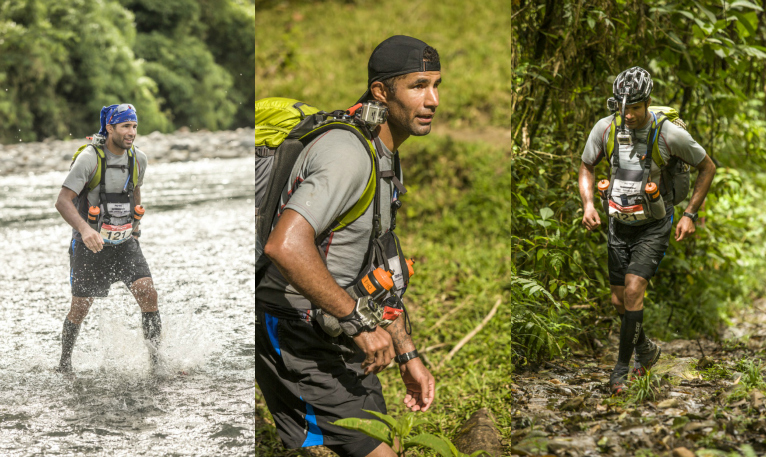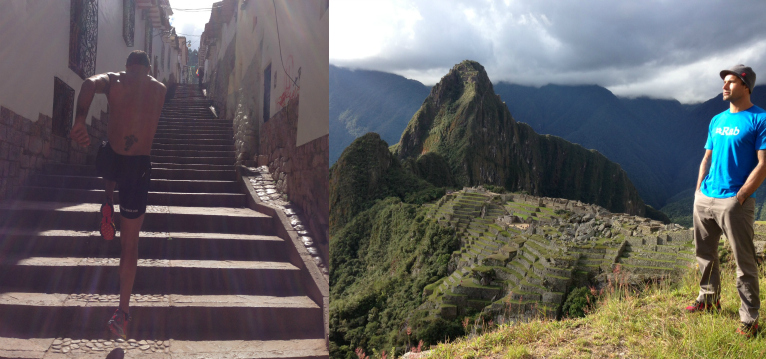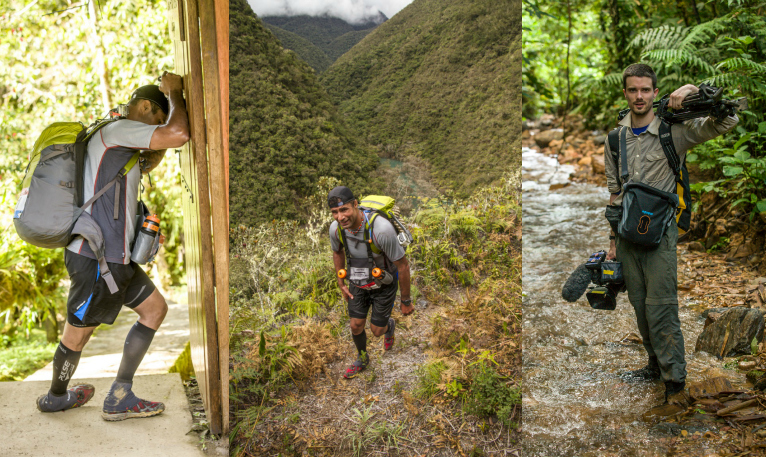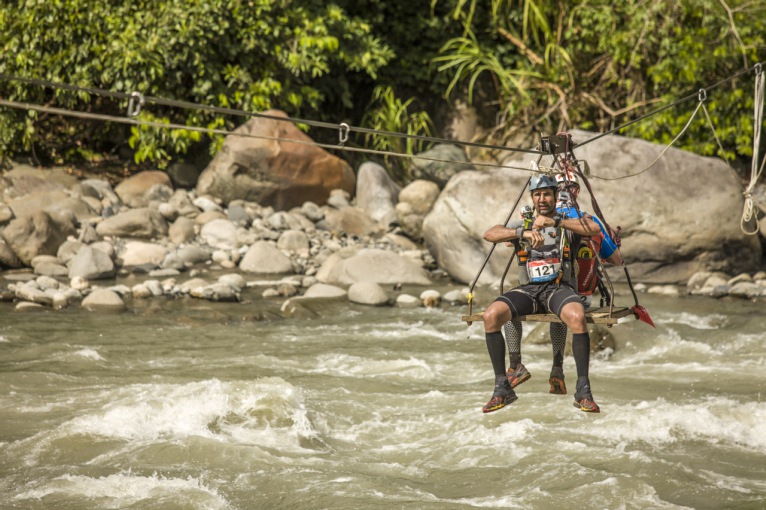Richard reflects on Jungle Ultra before episode 2 tomorrow.

Richard looks back on the Jungle Ultra marathon in Peru ahead of tomorrow’s episode of Xtreme Endurance: Race To The Pole.
In tomorrow’s episode of Richard’s new TV series, at 7pm on Channel 5, viewers will see Richard take on his second endurance event as part of his extreme preparation for a solo, unsupported and unassisted Antarctica Speed Expedition and World Record attempt.

Richard takes on the leg sapping 230km self supported Jungle Ultra from the Andes to the heart of the Peruvian Amazon Rainforest. In terms of ultra marathons, some pros have called it even more savage than the Marathon de Sables.

The jungle might seem an unlikely place to form part of your extreme preparation to ski solo to the South Pole, so Richard gives us an insight in to why he chose to take on the Jungle Ultra and provides a taster of what to expect tomorrow night.
What was the aim of the Jungle Ultra? Other than to make you entirely miserable!
Deprivation training plays a big part in preparation for my expeditions, and what I mean by deprivation training is putting myself in a situation which is uncomfortable and which I benefit from it as much psychologically, as I do from it physically and technically.
After the Carstesnz Pyramid leg of my 737 Challenge in West Papua, I vowed never to go back to the Jungle. It is an extremely hostile place to perform, because it’s just unrelenting and there’s no escaping it. The heat, the humidity, the bugs, the creatures, the river crossings - it puts a huge demand on your body as well as your equipment.
The aim of the Jungle Ultra was three-fold really.
Firstly we picked the Jungle Ultra marathon because of all above. Secondly, it was an opportunity to take the recovery systems that Nic (my physio) and I had trialled in the Yak Attack on to the next level, as this would be self-supported. Obviously Nic wasn’t going to be with me in Antarctica so this was a really good opportunity to test those recovery systems in an extreme environment.
Thirdly, it was a really important step towards the self-filming of my solo journey in Antarctica. In order to maintain the integrity of my solo Antarctica expedition, I was due to self-film my entire journey to the South Pole. This required a whole new toolbox of skills that I needed to develop and learn. Managing the humidity of the jungle, protecting the lens, the integrity of camera systems, managing the batteries and even just the psychology of being aware of filming and framing a shot whilst I am performing were vital. Then there’s filming video diaries at the end of the day when you are absolutely bollo**sed. All these skills were directly transferable to the Antarctica expedition.
You don’t have any ultra marathon pedigree, so what had you learnt about the race before you set off to Peru?
Obviously I have done a huge amount of running in preparation for the 737 Challenge and throughout my rugby career but this was my first time to cross the marathon mark, let alone in an ultra marathon event. What I particularly liked about the Jungle Ultra and the reason why I chose it, is that it isn’t a straight out and out footrace. There are parts of the race that are set at altitude and the race is self-supported, which means that we had to carry all our own gear for the 5 days - food, hammock, clothing and sleeping bag. It’s set in some of the most treacherous terrain on the planet which means that it requires skills above and beyond just being an ultra runner. This is was why I felt it would suit me in my preparation for Antarctica.
The longest distance you had ever run was 19km. You had never pushed yourself even beyond the marathon barrier running. Is it safe to say people might think you are mad when they watch this week’s episode?!
I am sure some of the people watching the show might think that yes!
My preparation started with a solo and unsupported R&D expedition in Antarctica a year before the actual speed record expedition. It’s very difficult to replicate the psychological, physiological and emotional challenges that I was going to face in my solo speed record expedition and short of going back to Antarctica three times before that final expedition, these I believe were the best options. Using my experience of performance and the expertise of the team I had around me, we chose different extreme events like the Jungle Ultra that wouldn’t just make interesting television but would give us novel preparation opportunities.
The nature of the events I did that year in these extreme environments also meant that often, unexpected results (both positive and negative) arose in the build up to Antarctica, which I might not have got if I opted for other more traditional training methods.
I had worked closely with the television production team and my performance team to devise the timetable of the 18 months of preparation, but one challenge that underpinned all the challenges I faced in these 18 months was managing the specific demands of each event. The challenge for me that year was also staying fit, healthy and not breaking down.
Richard working on functional strength at Sports Wales.
My regular cardiovascular fitness for Antarctica was largely based around the bike because of the low impact on my joints and the similar muscle group cycling uses compared to the prone position of pulling a pulk. From a running point of view, what unfortunately didn’t make the edit was the novel and ground breaking training that Nic and I had worked on at the Sports Wales Institute in Cardiff to manage a pre-existing chronic Achilles injury.
We worked intensely at developing functional strength and biomechanical efficiency, whilst limiting the miles that I ran in preparation for this event. I had limited my running to 19km staying pain free, so there was method behind the apparent madness! One element of this particular race that I am excited about is that we proved the ability to train and prepare for an endurance event successfully without the volume of training that you might previously expect. Some of these novel training methods are now being looked at and considered by other strength and conditioning coaches.
So, given all that work you put in, were you confident your Achilles would hold up and how were you feeling when you arrived in Peru?

Richard training in Cusco and then contemplating the Jungle Ultra at Machu Picchu.
I was confident in my ability to get through the race. I knew it would be one of attrition and one of mental resilience but I was a little nervous about physically holding up and how my Achilles would fair. All of these events would only be worthwhile if I finished them healthy enough to be able to build on what I had achieved in that event when I came back to Wales. Ultimately, I had complete faith in my work with Nic and the guys at the GSK Human Performance Lab and Sport Wales.
The Jungle Ultra is filled with the prospect of facing deadly snakes, cayman, jaguar and spiders to name a few, did that scare you?
I wasn’t scared of any of the creatures in the jungle before I went in, however I certainly wasn’t looking forward to any of it! It still remains one of the most uncomfortable environments that I have performed in and it is genuinely just a horrible place to be.
During the race I can remember one particular moment when I literally felt like I couldn’t take another step, so I just stopped and bent over putting my hands on my knees, just to try and grasp a few breaths in the humidity for a few seconds. I looked down and my entire trainers, entire shins were covered in ants, absolutely covered. If that is not an incentive to keep moving, I don’t know what is! That’s just one example - it’s a horrible place to be. You don’t want to put your hand down on anything in case it bites you or it’s alive, you don’t want to stop. I wasn’t scared, but I was not looking forward to any of it!
Your best day:
The best day was the last day again! Ha! Nic my physio always takes the pi*s out of me that I only really come in to my own after 24 hours! And the last day was a bit like that. I seemed to feel stronger and more confident as the day went on. Although the crazy rainstorm was potentially serious, it was actually an incredible experience and it is something that will live with me for a long time.
Your worst day:
The hardest day by far was day 4 - The Lull. In the race itinerary it’s the shortest day at 36km but being the penultimate day of the race we were all battered and running on empty. Although it’s the shortest distance day, it’s absolutely brutal. At times I was crawling on my hands and knees up really steep slopes and then falling, if not rolling down the other side all in the depths of the boiling hot jungle. It was a savage day.
How much did you actually run of it?
One of the reasons why I chose the Jungle Ultra it is there are many other skills required to completing it. I would say I probably ran 60% of it maybe. It’s virtually impossible to run all of it. You’re running, climbing, trudging, flying along zip wires, crossing rivers, wading…it’s pretty nuts. In the end you don’t care how you get there as long as you put one foot in front of the other and make it to the finish line.
We see you suffer with your knees too…
Yeah the terrain underfoot is unrelenting, its so varied; from river crossings to deep mud, to hard rock, to tree roots. I found it punishing on my body but as I mentioned before, there are no short cuts to developing resilience. With that in mind I felt that this event was huge success for me. I was sore and a bit battered for a while after, but came away with so much from it for Antarctica.
With an event such as this, there’s normally a few painful, surreal, bonkers or funny moments - what were yours?
One of the most painful things was my chafing, which you will all learn of tomorrow in finer detail!

One of the funniest things? As well as having to carry all my own camera equipment, I also wasn’t allowed to have any interaction with the film crew filming me. I didn’t know when they were going to turn up. For some reason one of the team; Mark Challender, who himself is a really good runner, always seemed to pull the short straw with the shooting location in the deepest, darkest, wettest, hottest most insect infested part of the jungle. So every day I would pass him at some point and he literally would be stood there behind the camera, sweating, covered in bugs, being eaten to sh*t and generally having a miserable time. In fact he probably had a much worse time than me throughout the entire race! That always made me smile! I know it sounds really mean but I can say that because I consider Mark a mate of mine now, but it was so funny!
For the gear geeks out there (including you) what were your most essential bits of kit?
One of the skills that really helped me for this event was having experience of packing an expedition sack and managing the weight of my gear.
For me my hammock was a real luxury, just falling asleep to the sound of the jungle every night in it was absolutely awesome, compared to a tent on the side of an icy mountain! But some of the runners were coming at it from a different angle and hardly slept a wink not being able to get to grips with it, but I loved my hammock.
I used a Rab Neutrino 200 sleeping bag, which is incredibly light and warm. I had confidence in my ability to protect the down fibres and to keep it dry in the humidity. Despite all the recovery systems I was testing which were working really well, there is no substitute for getting a good night’s sleep in the recovery game.
I chose to run in a Rab MeCo Tee. A lot of the other athletes were using synthetic fibres but having used MecCo (which is Merino Wool blend fibre) in the jungle previously and on every other expedition, it’s a fabric I really trust. I concluded that whatever fabric I wore, it’s going to be soaking wet from the rivers and sweating. You can’t escape +40 degrees heat and 100% humidity so the reason for my choice is that I felt it was more important to be comfortable next to skin, breathable and quick drying. For me my Rab MeCo layers are incredible. It might seem bizarre to wear a wool T-shirt in the Amazon jungle but it worked really well.

In Nepal for the Yak Attack, Nic and I had tested some recovery aids called firefly™ devices and they worked incredibly well flushing my legs of waste product and lactic at the end of the days. Even though every gram had to be accounted for in the Jungle Ultra, I chose to take my firefly™ devices for this race. Once again they worked really well. I put them on at the end of every day and fell asleep with my legs twitching, having a similar effect as an active recovery whilst I slept. They worked well again, and after this race I confirmed that I was going to use them in Antarctica.
This was also the first stage of working with Fuizion to develop my dehydrated Antarctica food. Some of the other athletes were jealous when I was eating Chicken and Broccoli stroganoff at the end of the day and they were eating what looked like rehydrated cardboard!
Finally, would you do it again and what would you do differently?
Yes! If I did it again I would definitely not carry 4kg of camera equipment!









